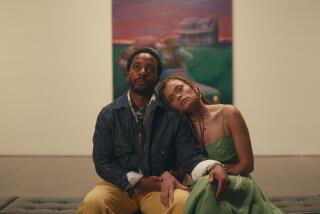Movie review: ‘Gerhard Richter Painting’ is revealing
- Share via
“Gerhard Richter Painting”is a mesmerizing look behind the curtain at a magician at work, a man who creates his enchantments not with a deck of cards or puffs of smoke but rather paint, brushes, canvas and a giant squeegee.
Now 80 years old, the German painter is considered one of the world’s greatest living artists, still creating dazzling work in his studio in Cologne. Famously publicity-shy, he made a 2007 short with filmmaker Corinna Belz called “Gerhard Richter’s Window,” an experience that went so well that he agreed to participate in this remarkable feature-length project.
Here, Belz has done more than record Richter creating some of his large-scale abstract canvases (just one of the numerous styles he works in); her rapport with the artist has led to Gerhard Richter Talking as well.
Still curious, still searching and questioning, Richter is a master perhaps nearing the end of his career, giving his thoughts about art, his process and even whether the whole notion of discussing how he does what he does is worth doing.
A serious man but playful, deeply thoughtful with a bit of a leprechaun quality, Richter pointedly wonders if “to talk about painting is perhaps pointless. You can only express in words what words are capable of expressing, what language can communicate. Painting has nothing to do with that. Painting is another form of thinking.”
As if to amplify that thought, we see Richter working on a series intended for a New York City gallery opening. We watch as he first applies paint in broad yet meticulous strokes and then uses an enormous metal squeegee, so big it looks like a piece of aluminum siding, to confidently scrape away parts of what he has painted on.
Unlike his figurative work, Richter considers his abstractions to be more instinctual than planned. “Something just happens” is how he puts it. “They do what they want,” he adds, smiling. “I planned something different.”
Continuing with this theme of personification, the artist quotes the philosopher Theodor Adorno about individual works of art being mortal enemies. “Each painting,” he says, “is an assertion that doesn’t tolerate company.” So how does he know when a painting is finished? “When nothing is wrong anymore, then I stop.”
“Gerhard Richter Painting” also offers glimpses into the artist’s nonpainting life. We witness him at a museum opening in London, planning a show with his New York gallerist Marian Goodman, even talking a bit about his personal story.
Richter was born in East Germany, and though he always enjoyed painting, he did not imagine it as a profession. He worked as a print shop apprentice, even a dental technician. “Now that,” he says, “was dreadful.” He fled to the West before he was 30 as a political refugee and consequently was never able to see his parents again.
One of this film’s most intriguing moments has Richter quietly confronting Belz and wondering whether giving her this kind of carte-blanche access was a good idea. Painting under observation, he says, is “the worst thing there is, worse than being in a hospital. The camera makes everything different, you feel so exposed.”
“Painting,” he says finally, “is a secret business, something you do in secret and reveal in public.” It is the achievement of “Gerhard Richter Painting” to shine a light on that hidden, private act as few other films have done.
-------------------------------
‘Gerhard Richter Painting’
No MPAA rating
Running time: 1 hour, 37 minutes
Playing: Laemmle’s Royal, West Los Angeles; NoHo 7 in North Hollywood; Playhouse 7 in Pasadena
More to Read
The biggest entertainment stories
Get our big stories about Hollywood, film, television, music, arts, culture and more right in your inbox as soon as they publish.
You may occasionally receive promotional content from the Los Angeles Times.











